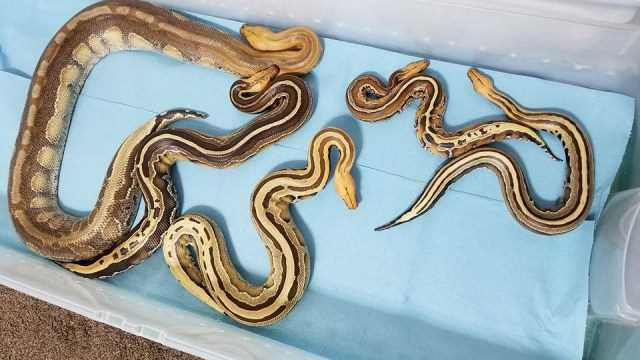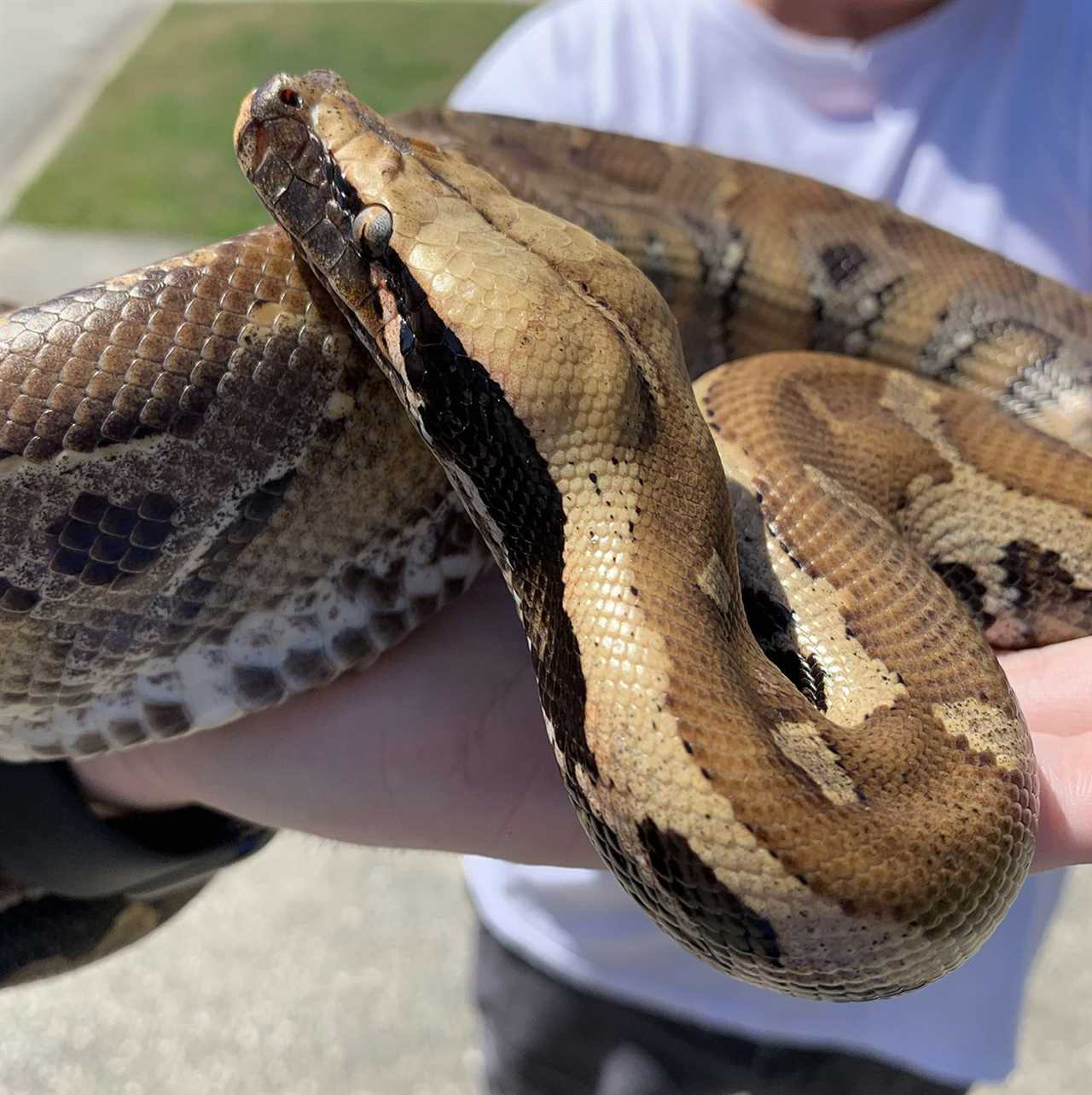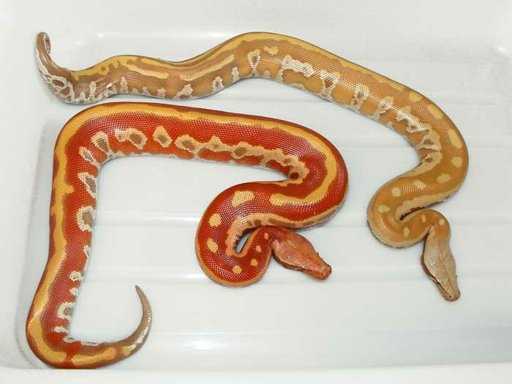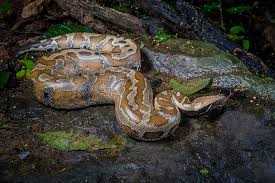
Feeding blood pythons is an important aspect of their care. As a species that primarily feeds on small mammals in the wild, they require a diet of appropriately sized rodents. Young blood pythons can be fed rat pups, while larger adults can consume adult rats. It’s essential to provide a varied diet to ensure that your python receives all the necessary nutrients. Additionally, always remember to thaw frozen rodents before offering them to your snake, as feeding frozen prey can lead to health issues.
Choosing the Right Habitat for Blood Python Care
Blood pythons are semi-aquatic snakes that require a combination of land and water in their enclosure. The enclosure should be large enough to accommodate their size and provide enough space for them to move around comfortably. A general rule of thumb is to provide a minimum enclosure size of 4 ft x 2 ft x 2 ft for an adult blood python.
1. Enclosure Material
2. Substrate
The substrate you choose for your blood python’s enclosure plays a vital role in maintaining proper humidity levels and overall cleanliness. Suitable substrate options include cypress mulch, coconut husk, or aspen bedding. Avoid using substrates that can cause impaction or mold, such as sand or gravel.
3. Temperature and Humidity
Blood pythons are native to warm and humid environments, so it is crucial to maintain the appropriate temperature and humidity levels in their enclosure. The optimal temperature range for blood pythons is between 85-90°F (29-32°C) on the warm side and 75-80°F (24-27°C) on the cool side. It is advisable to use a thermostat and heat sources like ceramic heat emitters or heat pads to regulate the temperature.
Humidity levels should be kept around 50-60% for blood pythons. This can be achieved by misting the enclosure regularly and providing a large water bowl for soaking. Using a hygrometer can help you monitor and maintain the humidity levels accurately.
4. Enrichment and Hiding Spots
5. Cleaning and Maintenance
Regular cleaning and maintenance of the enclosure are essential to ensure a hygienic and healthy environment for your blood python. Spot clean any feces or urates daily, and perform a deep clean of the enclosure monthly. This includes removing all substrate, cleaning the enclosure with a reptile-safe disinfectant, and thoroughly rinsing and drying everything before reintroducing your python to its enclosure.
By carefully considering and implementing these factors, you will be able to create an ideal habitat for your blood python, leading to a happy and healthy snake. Remember to always research and consult with experts to provide the best possible care for your blood python.
Setting Up the Terrarium for Blood Python Care
Creating the perfect enclosure for your blood python is essential for their health and well-being. A well-designed terrarium will ensure that your snake feels secure and comfortable in its environment. Here are some important factors to consider when setting up the terrarium:
2. Substrate: Choose a substrate that is easy to clean and provides good humidity levels. Newspaper, cypress mulch, or reptile bark are all suitable options for blood pythons.
3. Temperature: Maintaining the correct temperature gradient is crucial for the well-being of your blood python. Provide a basking spot at one end of the enclosure with a temperature of around 90°F (32°C), and a cooler area at the opposite end with a temperature around 80°F (27°C). Use thermostats and heat sources such as heat pads or ceramic heat emitters to regulate the temperature.
4. Humidity: Blood pythons require a humidity level of around 60-80%. To achieve this, mist the enclosure daily and provide a large water bowl for drinking and soaking.
5. Lighting: Blood pythons are primarily nocturnal and do not require special lighting. However, providing a natural day and night cycle can help regulate their internal clock. Use a timer to provide 12 hours of light and 12 hours of darkness.
6. Hiding Spots: Create multiple hiding spots throughout the enclosure using rocks, logs, or commercially available reptile hides. These hideouts will help your blood python feel secure and reduce stress.
By carefully considering these factors, you can provide an ideal habitat for your blood python. Remember to monitor the temperature, humidity, and cleanliness of the enclosure regularly to ensure the health and well-being of your snake.
The Importance of Selecting the Right Substrate for Blood Python Enclosure
1. Consider the Natural Habitat
When selecting a substrate for a blood python enclosure, it is essential to consider the snake’s natural habitat. Blood pythons are native to swampy areas in Southeast Asia, where they live among leaf litter, mud, and dense vegetation. Replicating this natural environment in captivity can help provide a sense of security and promote natural behaviors.
2. Ensure Proper Moisture Retention
3. Avoid Sharp and Ingestible Materials
It is crucial to avoid substrates with sharp edges or materials that the python may accidentally ingest while hunting or exploring its environment. This can cause injury or impaction, leading to serious health issues. Opt for substrates that are soft, smooth, and free of harmful chemicals.
Tip: Providing a layer of clean, dry newspaper or paper towels on top of the substrate can make cleaning easier and prevent direct contact between the snake and potentially harmful materials.
4. Easy Maintenance and Cleaning
5. Mind the Snake’s Size
By carefully selecting the right substrate for your blood python enclosure, you can create a comfortable and suitable habitat that promotes their well-being, mimicking their natural environment.
Maintaining the Ideal Temperature
One crucial aspect of blood python care is ensuring that the enclosure maintains the ideal temperature for the snake’s wellbeing. Blood pythons come from tropical regions and require specific temperature ranges to thrive.
The ideal temperature range for a blood python’s enclosure is between 80-90 degrees Fahrenheit (27-32 degrees Celsius) during the day. At night, the temperature can drop a few degrees but should still remain within the range of 75-85 degrees Fahrenheit (24-29 degrees Celsius).
To achieve and maintain the appropriate temperature, you can use a combination of heat sources such as under-tank heaters, heat lamps, and radiant heat panels. It is essential to monitor the temperature regularly using a reliable thermometer to ensure it stays within the proper range.
Keep in mind that factors such as room temperature and humidity can affect the temperature inside the enclosure. Regularly check and adjust the heating equipment as needed to maintain the ideal temperature for your blood python.
- Utilize heat sources like under-tank heaters and heat lamps to maintain the appropriate temperature.
- Monitor the temperature using a reliable thermometer to ensure it stays within the proper range.
- Provide a temperature gradient within the enclosure for the snake to thermoregulate.
- Regularly check and adjust the heating equipment to account for room temperature and humidity fluctuations.
By carefully maintaining the ideal temperature in the blood python’s enclosure, you can ensure their comfort, health, and overall well-being.
Proper Humidity for Blood Pythons: Maintaining the Ideal Environment
Why is humidity important for blood pythons?
Snakes, including blood pythons, rely on their environment to regulate their body temperature. In the wild, blood pythons inhabit areas with high humidity, such as rainforests and swamps. Therefore, recreating this high humidity in their enclosure is essential for their overall health and proper physiological functioning.
How to maintain the ideal humidity level
There are several methods you can employ to maintain the appropriate humidity level for blood pythons:
- Misting: Misting the enclosure with water is a straightforward and effective way to increase humidity. This can be done daily or as needed, depending on the current humidity level.
- Water Bowl: Providing a large water bowl in the enclosure can help maintain humidity levels. Blood pythons will often soak in the water bowl, which also helps with shedding.
- Humidifier: Using a humidifier in the room where the snake’s enclosure is located can help maintain a consistent humidity level. This is especially useful in drier climates.
- Substrate Choice: Choosing the right substrate can also contribute to maintaining humidity. Options such as coconut husk, sphagnum moss, or cypress mulch can help retain moisture in the enclosure.
It is essential to monitor the humidity level regularly with a hygrometer to ensure it stays within the appropriate range. The ideal humidity range for blood pythons is typically between 50% and 70%. Higher levels of humidity may be required during shedding periods.
Consequences of improper humidity
If the humidity level is too low, blood pythons may experience dehydration, difficulty shedding their skin, respiratory issues, and overall compromised health. On the other hand, excessively high humidity can lead to bacterial and fungal infections, including respiratory infections.
Establishing and maintaining the ideal humidity level is crucial for the overall well-being and health of blood pythons. Providing them with a habitat that mimics their natural environment will help ensure they thrive and live a long, healthy life.
Lighting Requirements for Blood Pythons
When choosing lighting for your blood python enclosure, it is crucial to consider the snake’s needs in terms of temperature regulation and day-night cycles. Blood pythons are crepuscular, which means they are most active during twilight hours.
In addition to the day-night cycle, providing full-spectrum lighting is also crucial for the overall health and well-being of your blood python. Full-spectrum lighting emits a broad spectrum of light, including UVB rays, which are essential for the synthesis of vitamin D3. Vitamin D3 is essential for proper calcium metabolism in reptiles. Without adequate UVB exposure, blood pythons can develop metabolic bone disease, which can be fatal if left untreated.
By providing the proper lighting requirements for your blood python, you can ensure that it thrives in captivity and exhibits natural behaviors. Consult with a reptile specialist or veterinarian to determine the best lighting setup for your specific snake.
Creating a Hiding Spot for Blood Python Care
The hiding spot can be created using various materials, such as rock caves, hollow logs, or commercially available reptile hide boxes. It should be spacious enough to allow the python to comfortably fit inside, while also providing a secure and enclosed environment.
Placing the hiding spot in a strategic location within the enclosure is also essential. It should be positioned in an area that provides adequate privacy for the python, away from excessive light or noise. This will help to create an environment where the blood python can feel safe and secure.
In summary, creating a suitable hiding spot is an integral part of blood python care. It provides a secure and enclosed environment where the snake can seek shelter and feel safe. By carefully considering the materials, placement, and monitoring, you can ensure the well-being and comfort of your blood python.
Caring for Blood Pythons: Feeding
Blood pythons are a popular choice among snake enthusiasts due to their stunning appearance and manageable size. Proper feeding is essential to ensure the health and well-being of these snakes.
Blood pythons are carnivores, which means they require a diet consisting solely of meat. In the wild, they primarily feed on small rodents and birds. As a responsible owner, it is crucial to replicate their natural diet in captivity.
Types of Prey to Offer
Frequency of Feeding
The frequency of feeding depends on the age and size of your blood python. Younger snakes should be fed more frequently, typically once every five to seven days. Adult blood pythons can be fed less frequently, typically every seven to ten days. It is crucial to monitor their body condition and adjust the feeding schedule accordingly.
Feeding Methods
Blood pythons are notorious for their aggressive feeding behavior. It is recommended to offer prey items using tongs or specialized feeding tools. This prevents accidental bites and minimizes the risk of your snake associating your hands with feeding.
Maintaining the Enclosure
After feeding, it is essential to provide a stress-free environment for your blood python. Handling should be avoided immediately after a meal to prevent regurgitation. Additionally, ensure that the enclosure is clean and free from any food debris or odors that could attract pests.
Monitoring the Snake’s Behavior

Regularly observing your blood python’s behavior is crucial in detecting any potential health issues. If your snake refuses to eat for an extended period, it may be a sign of illness or stress. In such cases, consulting a veterinarian experienced in reptile care is recommended.
Overall, proper feeding practices are vital in maintaining the health and happiness of your blood python. By providing a nutritious and varied diet, monitoring their behavior, and offering a stress-free environment, you can ensure that your snake thrives in captivity.
Feeding Blood Pythons: Types of Prey to Offer
1. Mice and Rats

2. Chicks and Quail
Chicks and quail are also suitable prey options for blood pythons, especially for larger individuals. These larger prey items can provide a more substantial meal and help promote a healthy growth rate. Make sure to adjust the size of the prey to match the snake’s size and feeding capabilities.
3. Other Small Birds

In addition to chicks and quail, blood pythons can also be fed other small birds such as finches, sparrows, or even small pigeons. These prey items can be a good source of variety in the python’s diet and can mimic natural feeding behaviors in the wild.
4. African Soft-furred Rats
Another option for blood python owners is African soft-furred rats. These rodents are smaller than regular rats but have a higher fat content, making them a more nutritious choice for your snake. They can be an excellent alternative to provide a varied diet for your blood python.
5. Small Rabbits
For larger adult blood pythons, small rabbits can be offered as a more substantial and challenging meal. Make sure to consult with a reptile veterinarian or an experienced snake keeper to ensure that the size of the rabbit is appropriate for your snake’s feeding capabilities.
Remember, feeding live prey to blood pythons is not recommended as it poses a risk of injury to both the snake and the prey item. It is safer and more humane to offer pre-killed or frozen-thawed prey that has been appropriately warmed up to mimic the snake’s natural body temperature.
When feeding your blood python, it is essential to observe their feeding response. If the snake shows signs of stress or refuses to eat, it may be necessary to adjust the prey size or type. Regularly monitor their weight and overall condition to ensure that they are receiving a balanced diet and maintaining a healthy body condition.
Frequency of Feeding
After feeding, it is recommended to give your blood python at least 48 hours of undisturbed rest to allow for proper digestion. Handling or disturbing the snake during this time can disrupt the digestion process and may lead to regurgitation.
Remember, providing proper care and maintaining a consistent feeding schedule are essential for the health and well-being of blood pythons. With the right enclosure, temperature, humidity, and handling, these beautiful snakes can thrive under your care.
Handling and Socialization
It’s essential to create a calm and stress-free environment when handling your blood python. Make sure the enclosure is secure and that there are no distractions or loud noises that could startle the snake. Approach the snake slowly and gently, allowing it to become familiar with your scent before attempting to touch it.
When picking up your blood python, support its body and allow it to wrap around your arm or hand. Avoid grabbing or squeezing the snake, as this can cause stress and potentially harm the snake. Keep in mind that blood pythons are powerful constrictors, so be prepared for their strong grip.
Remember to always wash your hands before and after handling your blood python to prevent the spread of any bacteria or diseases. Wash any equipment used for handling, such as hooks or tongs, as well. Regular handling and socialization can also help identify any changes in your snake’s behavior or health, allowing you to address any issues promptly.
Conclusion
Handling and socialization are important aspects of blood python care. By approaching your snake with caution and respect, you can ensure a positive and stress-free experience for both yourself and your snake. Regular handling sessions help build trust and allow for early detection of any health issues. With proper care and attention, your blood python can thrive in its enclosure and become a fascinating and rewarding pet.
Common Health Issues in Blood Pythons
Respiratory Infections
Respiratory infections are one of the most common health problems in blood pythons. They can be caused by a variety of factors, including poor husbandry, inadequate temperature and humidity levels, and stress. Symptoms of respiratory infections may include wheezing, difficulty breathing, mucus discharge from the nose or mouth, and loss of appetite. If you notice any of these signs, it is crucial to consult a reptile veterinarian for proper diagnosis and treatment.
Parasites
Like many other snakes, blood pythons can be prone to internal and external parasites. Common parasites that can affect them include mites, ticks, and internal worms. Regularly checking your snake for any signs of parasites, such as excessive scratching or visible bugs, is important. If you suspect your snake has parasites, it is crucial to consult a reptile veterinarian for proper diagnosis and treatment.
Skin Infections
Dehydration
Metabolic Bone Disease
Metabolic bone disease (MBD) is a common health issue in captive snakes, including blood pythons. It is caused by a deficiency in calcium, vitamin D, or both, leading to weakened bones and other related problems. Symptoms of MBD may include soft or misshapen bones, tremors, difficulty shedding, and lethargy. Providing a proper diet and UVB lighting is crucial to prevent MBD. If you suspect your snake has MBD, consult a reptile veterinarian for proper diagnosis and treatment.
By being vigilant about the health of your blood python and seeking proper veterinary care when needed, you can help ensure a long and healthy life for your pet snake.
Signs of Illness in Blood Pythons: What to Look For
2. Respiratory Issues: Respiratory infections are common in snakes and can be caused by poor enclosure conditions or stress. Signs of a respiratory infection include wheezing, labored breathing, excessive mucus, and bubbles coming from the nostrils.
3. Unusual Shedding: Shedding is a normal process for snakes, but if a blood python is experiencing difficulties or delays during shedding, it may be a sign of underlying health issues. Look for retained eyecaps, incomplete shedding, or prolonged periods of difficulty in removing the old skin.
4. Abnormal Droppings: Pay attention to the appearance and consistency of your blood python’s droppings. Diarrhea, mucus, blood, or undigested food can all indicate possible health problems.
5. Behavioral Changes: If your blood python is suddenly displaying unusual behaviors such as lethargy, aggression, or excessive hiding, it could be a sign of illness. Sick snakes may also show signs of weakness, paralysis, or disorientation.
6. Mouth and Face Abnormalities: Swollen or discolored areas around the mouth or face can be indicators of infection or injury. Pay attention to any changes in the appearance of your snake’s head and mouth.
If you notice any of these signs or suspect illness in your blood python, it is crucial to seek veterinary care immediately. Blood python health issues can worsen rapidly, so early intervention is essential for successful treatment. Remember to provide proper humidity, feeding, and handling to minimize the risk of illness and keep your blood python healthy and thriving.
Seeking Veterinary Care for Blood Python: Ensuring the Health and Well-being of Your Snake
If you notice any signs of illness in your blood python, it’s best to consult with a reptile veterinarian as soon as possible. Some common signs of illness in blood pythons include loss of appetite, regurgitation, lethargy, respiratory issues, skin problems, and abnormal shedding. These symptoms can be indicators of underlying health problems that require immediate attention.
The reptile veterinarian may conduct a thorough physical examination, including checking the snake’s mouth, respiratory system, skin, and overall body condition. They may also request additional diagnostic tests such as fecal examinations, blood tests, or X-rays to further evaluate the snake’s health.
Regular check-ups with a reptile veterinarian are also crucial for monitoring the overall health of your blood python. These check-ups can help detect any potential health issues before they become more serious and ensure that your snake receives appropriate preventive care.

I’m Lena Adams—a product of an unconventional upbringing in the African wilderness. My father, a daring explorer of African wildlife, sparked my fascination with reptiles, a passion that intertwined with the tragic loss of my mother during an expedition, leaving an indelible mark on my life. Driven to understand the creatures that captivated my parents, I embarked on my journey, sharing insights about reptiles, frogs, and lizards on my website. Through my explorations and conservation efforts, I honour my family’s legacy while seeking connections—to the creatures, nature, and the mother whose presence I yearn to understand.
